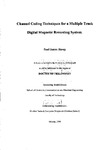CHANNEL CODING TECHNIQUES FOR A MULTIPLE TRACK DIGITAL MAGNETIC RECORDING SYSTEM
| dc.contributor.author | Davey, Paul James | |
| dc.contributor.other | School of Engineering, Computing and Mathematics | en_US |
| dc.date.accessioned | 2013-11-06T11:27:47Z | |
| dc.date.available | 2013-11-06T11:27:47Z | |
| dc.date.issued | 1994 | |
| dc.identifier | NOT AVAILABLE | en_US |
| dc.identifier.uri | http://hdl.handle.net/10026.1/2627 | |
| dc.description.abstract |
In magnetic recording greater area) bit packing densities are achieved through increasing track density by reducing space between and width of the recording tracks, and/or reducing the wavelength of the recorded information. This leads to the requirement of higher precision tape transport mechanisms and dedicated coding circuitry. A TMS320 10 digital signal processor is applied to a standard low-cost, low precision, multiple-track, compact cassette tape recording system. Advanced signal processing and coding techniques are employed to maximise recording density and to compensate for the mechanical deficiencies of this system. Parallel software encoding/decoding algorithms have been developed for several Run-Length Limited modulation codes. The results for a peak detection system show that Bi-Phase L code can be reliably employed up to a data rate of 5kbits/second/track. Development of a second system employing a TMS32025 and sampling detection permitted the utilisation of adaptive equalisation to slim the readback pulse. Application of conventional read equalisation techniques, that oppose inter-symbol interference, resulted in a 30% increase in performance. Further investigation shows that greater linear recording densities can be achieved by employing Partial Response signalling and Maximum Likelihood Detection. Partial response signalling schemes use controlled inter-symbol interference to increase recording density at the expense of a multi-level read back waveform which results in an increased noise penalty. Maximum Likelihood Sequence detection employs soft decisions on the readback waveform to recover this loss. The associated modulation coding techniques required for optimised operation of such a system are discussed. Two-dimensional run-length-limited (d, ky) modulation codes provide a further means of increasing storage capacity in multi-track recording systems. For example the code rate of a single track run length-limited code with constraints (1, 3), such as Miller code, can be increased by over 25% when using a 4-track two-dimensional code with the same d constraint and with the k constraint satisfied across a number of parallel channels. The k constraint along an individual track, kx, can be increased without loss of clock synchronisation since the clocking information derived by frequent signal transitions can be sub-divided across a number of, y, parallel tracks in terms of a ky constraint. This permits more code words to be generated for a given (d, k) constraint in two dimensions than is possible in one dimension. This coding technique is furthered by development of a reverse enumeration scheme based on the trellis description of the (d, ky) constraints. The application of a two-dimensional code to a high linear density system employing extended class IV partial response signalling and maximum likelihood detection is proposed. Finally, additional coding constraints to improve spectral response and error performance are discussed. | en_US |
| dc.description.sponsorship | Hewlett Packard, Computer Peripherals Division (Bristol) | en_US |
| dc.language.iso | en | en_US |
| dc.publisher | University of Plymouth | en_US |
| dc.title | CHANNEL CODING TECHNIQUES FOR A MULTIPLE TRACK DIGITAL MAGNETIC RECORDING SYSTEM | en_US |
| dc.type | Thesis | |
| plymouth.version | Full version: final and full version as approved by the examiners at the time of the award of your degree | en_US |
| dc.identifier.doi | http://dx.doi.org/10.24382/1595 | |
| dc.identifier.doi | http://dx.doi.org/10.24382/1595 |
Files in this item
This item appears in the following Collection(s)
-
01 Research Theses Main Collection
Research Theses Main


